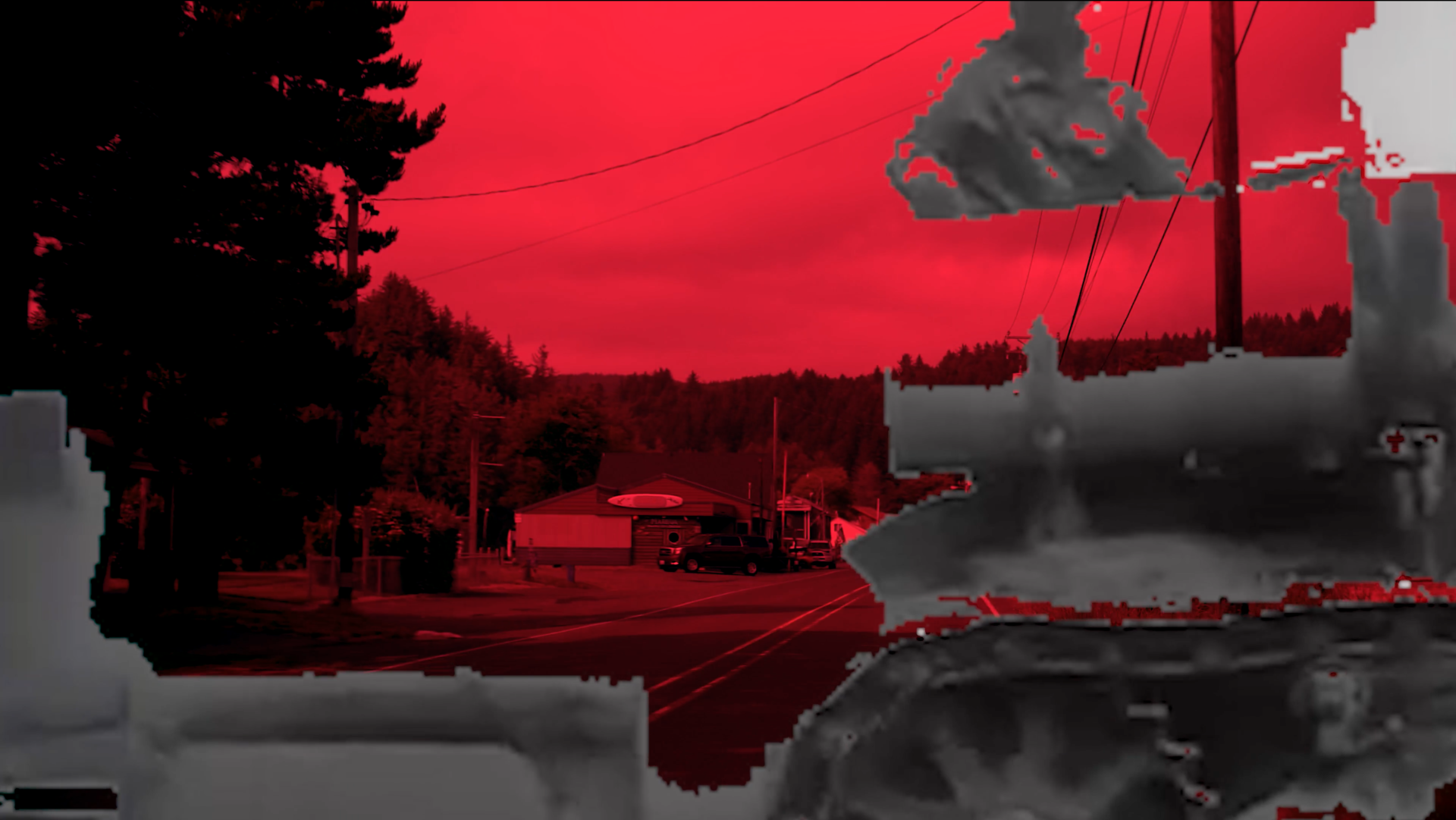
THE DRIVE on Highway 26 from Portland to the Oregon coast is fairly short and mindless to those familiar with the area. Woodrow Hunt’s ten-minute short film, “Faces, Displays, and Other Imaginary Things” offers a new perspective on this route and highways like it, reaching into the complicated past of Indigenous labor and remembering it for what it is. Hunt, who is of Klamath, Modoc and Cherokee descent, connects this film to his family’s labor experience.
Hunt’s film was screened virtually from Oct. 22-24 at ImagineNATIVE, the world’s largest Indigenous film and media arts festival. ImagineNATIVE is based in Toronto and includes both digital and in-person events showcasing a variety of Indigenous creators.
The experimental-style film features both red-tinted and unfiltered footage from a car’s passenger seat as it drives west on Highway 26. Text crawls onto the screen describing the 1933-42 Civilian Conservation Corps founded by President Franklin D. Roosevelt, a work relief program that improved the economic conditions of many Indigenous laborers, but also developed on and forever changed their land.
The film shows archival footage of Indigenous workers in the Civilian Conservation Corps and cuts between said footage and shots from the car. The screen then layers both, with the low-resolution black-and-white archival footage clipping in and out.
Hunt found his passion in filming Indigenous stories after working with LC alumnus David Shapiro ’17 on a short video promoting Senate Bill 13, regarding the inclusion of Native curriculum in Oregon’s public schools.
“That was a completely different experience than I had previously on different types of projects, and it was because of the subject matter, community and who I was working with.” Hunt said.
After this, Hunt founded Tule Films, an Indigenous production company that focuses on telling Indigenous stories exclusively. Hunt works with non-Natives so long as the project has significant involvement from Indigenous people excluding himself.
Still, Hunt wanted to explore more creative endeavors. The film and story techniques he had learned in school did not accurately reflect the ideas Hunt was trying to express, and he felt disconnected from other creators. Then, Hunt’s brother introduced him to experimental Native filmmakers.
Hunt named “INAATE/SE/,” Adam and Zack Khalil’s 2016 experimental documentary re-imagining an Ojibway story, as a specific inspiration.
“Seeing (“INAATE/SE/”) was kind of this breakthrough, open-the-floodgates type film for me,” Hunt said. “I finally was seeing someone making a documentary that was not standard in any way, breaking the form to communicate underlying ideas.”
Hunt also listed Sky Hopinka, Alexandra Lazarowich and Thirza Cuthand as Indigenous filmmakers that influenced him.
With a more experimental approach in mind, Hunt and his girlfriend and creative partner Olivia Camfield made the short film “We Only Answer Our Land Line” in 2019. Some techniques from this film are repeated in “Faces, Displays, and Other Imaginary Things” to create a “common language” between works.
Both films utilize digital zooming as a stylistic device; in “We Only Answer Our Land Line” the camera zooms in on repeating archival footage of Hunt’s grandmother walking until the viewer can only see pixels. “Faces, Displays, and Other Imaginary Things” echoes this with a clip of a dam with water rushing out of it, once again zooming in until the subject is unrecognizable.
Hunt and Camfield also use layering, placing both photographs and videos over base footage.
“There is this aspect of visible layering, but in the editing I am layering clips to get these effects, so often there is this internal layering not seen at all.” Hunt said. “I don’t do a clean edit and clean up my timeline; I will leave clips underneath the footage even when I am not showing you they are underneath.”
When the idea for “Faces, Displays, and Other Imaginary Things” came, Hunt was expecting a simple project. The route on Highway 26 was a familiar one: Hunt and his brother often took this drive to visit their grandparents who live at the beach.
“What was coming up was the question of ‘who made these roads? Who put these roads together?’” Hunt said. “It led to looking at labor projects, which was when I was introduced to information about the Civilian Conservation Corps. It then became a kind of remembering and looking beyond these routes to focus on the history of Indigenous labor in this area.”
In the twentieth century, Hunt’s great-grandparents moved to Vanport from southern Oregon to work in the shipyards. The same grandmother Hunt and his brother were visiting was born in Vanport before its historic flood, therefore displacing his family to Portland. This story influenced Hunt’s focus on Indigenous labor, particularly in the Pacific Northwest.
In examining the effects of labor projects on the land and the lives of the Indigenous people living there, Hunt aimed to take no stance on their morals with his film.
“I was not looking at (labor projects) as a purely malicious act; there was autonomy in those people and those workers to make decisions for themselves and their needs at the time,” Hunt said. “It is trying to remember this complicated experience.”
Subscribe to the Mossy Log Newsletter
Stay up to date with the goings-on at Lewis & Clark! Get the top stories or your favorite section delivered to your inbox whenever we release a new issue.

Leave a Reply